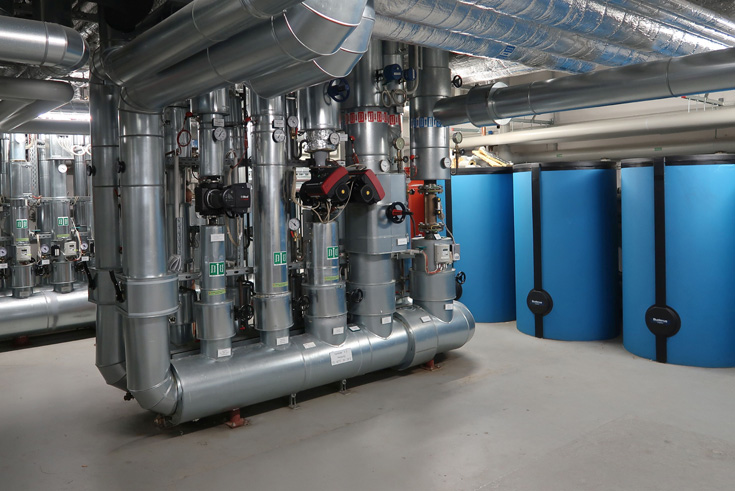Aquifer stores: Cooling in the summer and heating in the winter

Umweltschonend Kälte im Sommer und Wärme im Winter: Dafür sorgt bei einem Hotel und zwei Bürogebäuden am Bonner Bogen ein unterirdischer Aquiferspeicher (Foto: Paul Fleuchhaus, KIT).
Aquifers are water-bearing layers in the subsoil in which the water doesn't flow or hardly flows – in other words, the heat is not transported away. They are tapped through boreholes in order to heat the water underground with the waste heat from industrial plants or solar heat, with the surrounding rock acting as an insulator. The stored heat can then be retrieved via heat exchangers if required, for example in winter. The storage of summer heat or waste heat from industrial plants in aquifers is widespread in the Netherlands, for example, with the country already having implemented this technology at over 2,800 locations.
In Germany, there are currently only a few sites with geothermal energy storage in aquifers, the most prominent example being the Reichstag building in Berlin, which is supplied with heat in winter and cold in summer via several aquifer stores. Hamburg is currently planning an enormous aquifer heat storage facility, which in future will heat more than a quarter of a million households and businesses in the winter.
In a new project, researchers are now evaluating the effectiveness of one of the largest aquifer-bound geothermal plants in Europe. Since 2009, an underground aquifer storage facility has been supplying the Hotel Kameha Grand and two office complexes on the Bonner Bogen, a newly developed, commercially-used area on the banks of the Rhine, with environmentally-friendly cold in the summer and heat in the winter. The plant provides up to 80 percent of the heating and cooling requirement for the buildings, which cover a total area of around 60,000m2. Compared to a conventional energy supply, the geothermal plant saves around 1,700 megawatt hours of energy and 400 tonnes of CO2 annually. Geologists and experts for energy and building services engineering are working together to evaluate and adapt the plant to changing climatic conditions. "Due to the changing climate, we have to cool rooms instead of heating them in March", reports Philipp Blum, Professor at the Institute of Applied Geosciences (AGW) at KIT. Scientists predict that the energy demand for air-conditioning systems will increase 33-fold by the year 2100.
According to researchers, numerous regions in Germany and Europe, but also worldwide, are suitable for aquifer-based geothermal energy due to the geological ground conditions. Due to the large capacities, aquifer storage facilities are particularly commercially suited to large buildings such as museums, hospitals, offices and hotels. Aquifer storage facilities in combination with local heating networks are also suitable for contiguous housing estates. In the Netherlands, the technology is also used, for example, for industrial complexes such as greenhouses and data centres. The scientists' calculations show that with aquifer storage facilities, a return on investment is often achieved after just two to ten years.
Under the leadership of the KIT, the project partners are scientifically evaluating eight geothermal projects in Baden-Württemberg. The topics range from innovative monitoring and storage concepts, detailed heat-transport models, and investigations of hydrogeochemistry, to far-reaching system and optimisation analyses and tailor-made communication strategies.
In Germany, there are currently only a few sites with geothermal energy storage in aquifers, the most prominent example being the Reichstag building in Berlin, which is supplied with heat in winter and cold in summer via several aquifer stores. Hamburg is currently planning an enormous aquifer heat storage facility, which in future will heat more than a quarter of a million households and businesses in the winter.
In a new project, researchers are now evaluating the effectiveness of one of the largest aquifer-bound geothermal plants in Europe. Since 2009, an underground aquifer storage facility has been supplying the Hotel Kameha Grand and two office complexes on the Bonner Bogen, a newly developed, commercially-used area on the banks of the Rhine, with environmentally-friendly cold in the summer and heat in the winter. The plant provides up to 80 percent of the heating and cooling requirement for the buildings, which cover a total area of around 60,000m2. Compared to a conventional energy supply, the geothermal plant saves around 1,700 megawatt hours of energy and 400 tonnes of CO2 annually. Geologists and experts for energy and building services engineering are working together to evaluate and adapt the plant to changing climatic conditions. "Due to the changing climate, we have to cool rooms instead of heating them in March", reports Philipp Blum, Professor at the Institute of Applied Geosciences (AGW) at KIT. Scientists predict that the energy demand for air-conditioning systems will increase 33-fold by the year 2100.
According to researchers, numerous regions in Germany and Europe, but also worldwide, are suitable for aquifer-based geothermal energy due to the geological ground conditions. Due to the large capacities, aquifer storage facilities are particularly commercially suited to large buildings such as museums, hospitals, offices and hotels. Aquifer storage facilities in combination with local heating networks are also suitable for contiguous housing estates. In the Netherlands, the technology is also used, for example, for industrial complexes such as greenhouses and data centres. The scientists' calculations show that with aquifer storage facilities, a return on investment is often achieved after just two to ten years.
Under the leadership of the KIT, the project partners are scientifically evaluating eight geothermal projects in Baden-Württemberg. The topics range from innovative monitoring and storage concepts, detailed heat-transport models, and investigations of hydrogeochemistry, to far-reaching system and optimisation analyses and tailor-made communication strategies.

